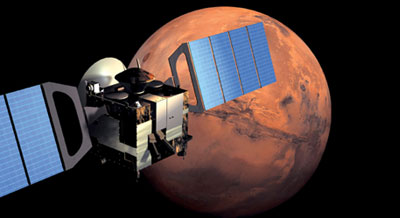Why is Mars so hard?<< page 2: what’s wrong today? Current mission prospectsHave the lessons described by the MAPLD panel been taken to heart by the latest generation of missions soon to head on their way to the Red Planet? Despite the reassurances of panel members and space agency officials alike, there are concerns that these missions could face some of the problems as their predecessors. MER faced a number of development issues, ranging from software to spacecraft mass, which, according to some media reports endangered plans to launch both rovers. There are also concerns about the complexity of MER, according to a study of past and present NASA spacecraft reported in the May 26 issue of Aviation Week & Space Technology. The Aerospace Corporation study assigned each mission a “Complexity Index” score between 0 and 1: 0 for the least-complex mission in the study group and 1 for the most complex. MER received a Complexity Index score of 0.81, putting it the same category of missions as NASA’s flagship outer planetary missions Galileo and Cassini. The study then plotted these complexity scores versus the development time of the missions: 34 months in the case of MER. When compared to other past NASA missions, this combination of complexity and development time is ominous. Successful complex missions tend to have much longer development periods, on the order of 80 to 90 months. Successful missions with MER’s development time tended to be less complex, with Complexity Indices of 0.5 or less. MER finds itself in the bottom-right corner of the chart, near a group of failed missions (marked in red on the Aviation Week chart) with similar development times and complexity indices of roughly 0.6 to 0.75. As the Aviation Week article put it, MER “sits in a sea of red dots of failure.”
MER’s prospects look more encouraging when looking at its budget. Using a very low development cost estimate of $480 million (excluding the cost of launch as well as building the second rover), MER falls in a group of largely successful missions with similar Complexity Indices and budgets. “MER is very fast, but we think NASA funded it adequately,” the Aerospace Corporation’s David Bearden, who performed the study for NASA, concluded to Aviation Week. Meanwhile, ESA breaks new ground with Mars Express. The spacecraft is not the most complex it has built—that honor most likely goes to Rosetta—but it does represent a new approach that calls for building spacecraft “faster, smarter, and more cost-effective,” according to a recent ESA information note. ESA trimmed a third off the usual development time for major planetary missions, completing Mars Express in four years rather than six. It also built the spacecraft for 300 million euros, a significant decrease from previous ESA planetary missions: Rosetta has cost ESA an estimated 1 billion euros. ESA officials credit the decreased schedule and cost of Mars Express on the reuse of existing hardware and instruments, as well as a smaller project team. ESA insists, though, that quality was never sacrificed. “Although we were under heavy pressure towards the end of the project, we did not drop any of the planned tests to save time,” said project manager Rudi Schmidt. Nonetheless, the specter of past failures hangs over this latest generation of Mars missions. “After the two 1999 failures and the shuttle Columbia disaster, the agency cannot afford to fail,” Florida Today concluded in an editorial published June 1. “It desperately needs to again show its prowess and improve its tarnished image.” The danger is that kind of pressure may end up doing more harm than good. Home |
|
